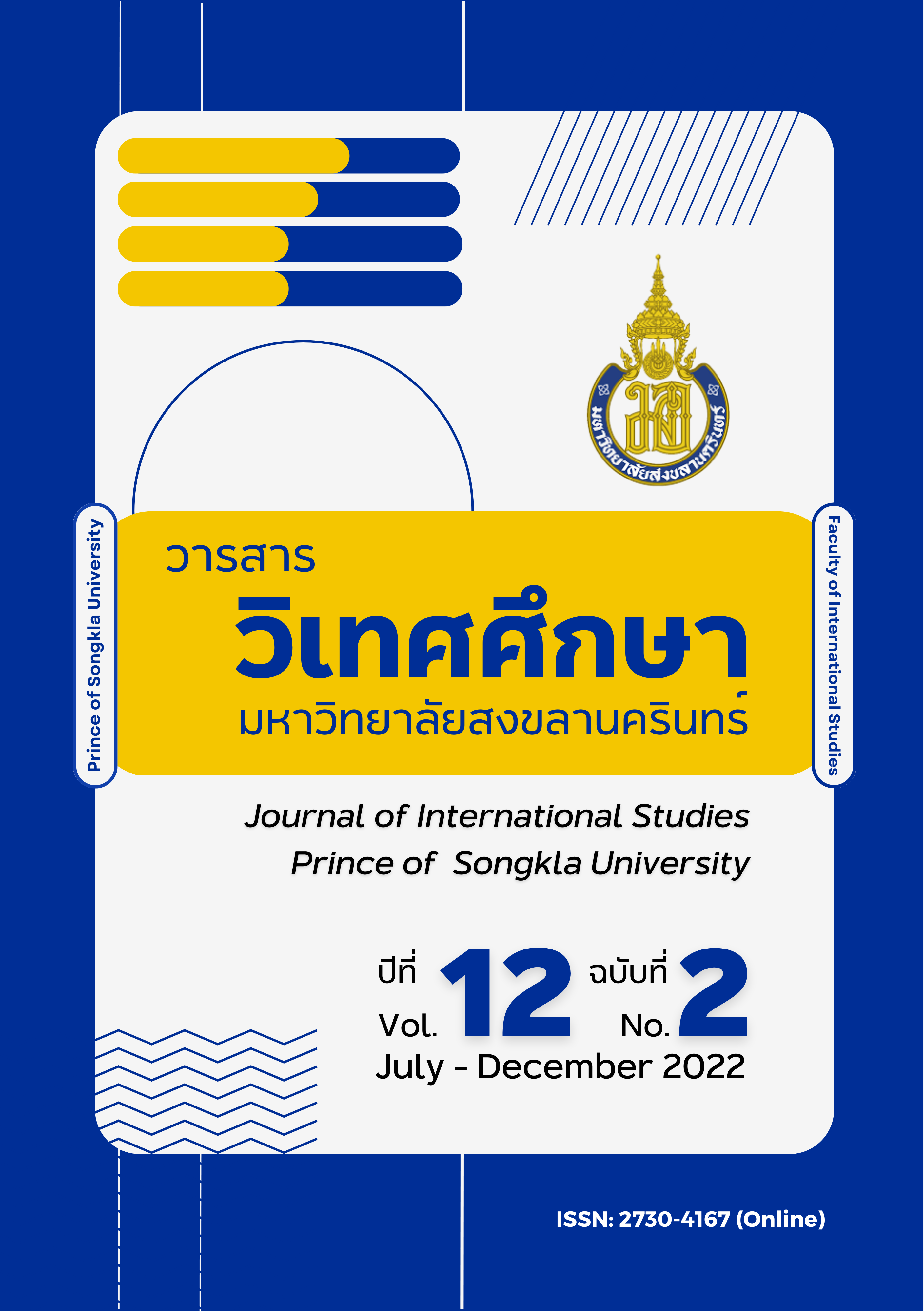Chinese language curriculum design and supplementary activities for Upper Secondary schools in Southern Thailand
Main Article Content
Abstract
The objectives of this article are to develop the supplementary activities on the Chinese curriculum at the upper secondary education level for curriculum design of the Southern Region schools in order to be a detailed, complete, diverse, and can be widely applied to the management of teaching Chinese courses at the high school level. The research result revealed that ten categories of the supplementary curriculum are developed and subdivided into fifty sub–activities, all contents and substance of activities are effectively used, and developed in accordance with the basic core curriculum, indicators, and Chinese learning content of the national and international standards. The strengths of these supplementary curriculum are 1) Objectives and goals are clear and consistent with the national and international curriculum, 2) Learning contents is diverse, covering all the content and suitable for the learner’s current needs, 3) Levels of vocabulary and conversation situations are based on the HSK (Chinese Language Proficiency Test), and 4) Reflect the identity of the teaching Chinese in the Southern Region that focuses on applying Chinese to tourism industry. The weak points of the supplementary activities are: 1) The supplementary curriculum activities are designed for the secondary school level and do not cover the elementary school level; and 2) Supplementary activities curriculum is designed for teaching management under normal situations and has limitation to teach online
Article Details

This work is licensed under a Creative Commons Attribution-NonCommercial-NoDerivatives 4.0 International License.
Statements and opinions expressed in articles herein are those of the authors and do not necessarily reflect the position of the editors or publisher.
Article, information, text, image, etc. which are published in Journal of International Studies, belong to Journal of International Studies. If anybody or any organization would like to use part or whole of them, they must receive written permission from Journal of International Studies before usage.
References
กระทรวงศึกษาธิการ. (2551). หลักสูตรแกนกลางการศึกษาขั้นพื้นฐาน พุทธศักราช 2551. กรุงเทพฯ: โรงพิมพ์ชุมนุมสหกรณ์การเกษตรแห่งประเทศไทย จำกัด.
ธำรง บัวศรี. (2542). ทฤษฎีหลักสูตร: การออกแบบและการพัฒนา. กรุงเทพ ฯ: ธนธัชการพิมพ์.
พิชัย แก้วบุตร. (2563ก). การศึกษาแนวทางการจัดทำหลักสูตรภาษาจีนระดับมัธยมศึกษาตอนปลาย สำหรับการจัดทำหลักสูตรสถานศึกษาภูมิภาคภาคใต้. วารสารวิเทศศึกษา มหาวิทยาลัยสงขลานครินทร์, 10(2), 94-119. https://so03.tci-thaijo.org/index.php/jis /article/view/248443
พิชัย แก้วบุตร. (2563ข). การศึกษาแนวทางการจัดทำหลักสูตรภาษาจีนระดับมัธยมศึกษาตอนปลายสำหรับการจัดทำหลักสูตรสถานศึกษา ภูมิภาคภาคใต้ (รายงานการวิจัย). สุราษฎร์ธานี: มหาวิทยาลัยสงขลานครินทร์ วิทยาเขตสุราษฎร์ธานี.
พิชัย แก้วบุตร. (2563ฃ). ความสนใจของนักศึกษาต่อกิจกรรมเสริมนอกชั้นเรียนวิชาภาษาจีน: กรณีศึกษานักศึกษาวิชาภาษาจีนมหาวิทยาลัยสงขลานครินทร์ วิทยาเขตสุราษฎร์ธานี. วารสารศรีนครินทรวิโรฒวิจัยและพัฒนา (สาขามนุษยศาสตร์และสังคมศาสตร์), 12(23), 27-38. https://so04.tci-thaijo.org/index.php/swurd/article /view/244100
พิชัย แก้วบุตร. (2564ก). การวิเคราะห์หลักสูตรภาษาจีนระดับมัธยมศึกษาตอนปลายสำหรับการจัดทำหลักสูตรสถานศึกษา ภูมิภาคภาคใต้. วารสารวิชาการ มหาวิทยาลัยราชภัฏภูเก็ต, 17(1), 59-77. https://so05.tci-thaijo.org/index.php/pkrujo/article/view /241992
พิชัย แก้วบุตร. (2564ข). สภาพและปัญหาการจัดการเรียนการสอนภาษาจีนในโรงเรียนระดับมัธยมศึกษาสังกัดรัฐบาล ภูมิภาคภาคใต้. วารสารมนุษยศาสตร์และสังคมศาสตร์ มหาวิทยาลัยราชภัฏสุราษฎร์ธานี, 13(1), 59-83. https://e-journal.sru.ac.th/index.php/jhsc/article /view/1144
โรบินสัน เคน. (2559). โรงเรียนบันดาลใจ (วิชยา ปิดชามุก, ผู้แปล). กรุงเทพฯ: โอเพ่นเวิลด์ส พับลิชชิ่ง เฮาส์.
สำนักงานเลขาธิการสภาการศึกษา. (2559). รายงานการวิจัยเพื่อพัฒนาการเรียนการสอนภาษาจีนในประเทศไทยระดับมัธยมศึกษา. กรุงเทพฯ: บริษัท พริกหวานกราฟฟิค จำกัด.
Chang, J. (2009). Chinese Vocabulary Culture. Beijing: Beijing Language University Press. (In Chinese)
Wang, X. (2014). On the Cultural Activities in the Context of International Chinese Language Education. Journal of Yunnan Normal University, 12(5), 1-5. (In Chinese)
Zhang, H. (2014). Reflections on the cultural activities organized by Confucius Institutes. Journal of Yunnan Normal University, 12(5), 6-12. (In Chinese)


